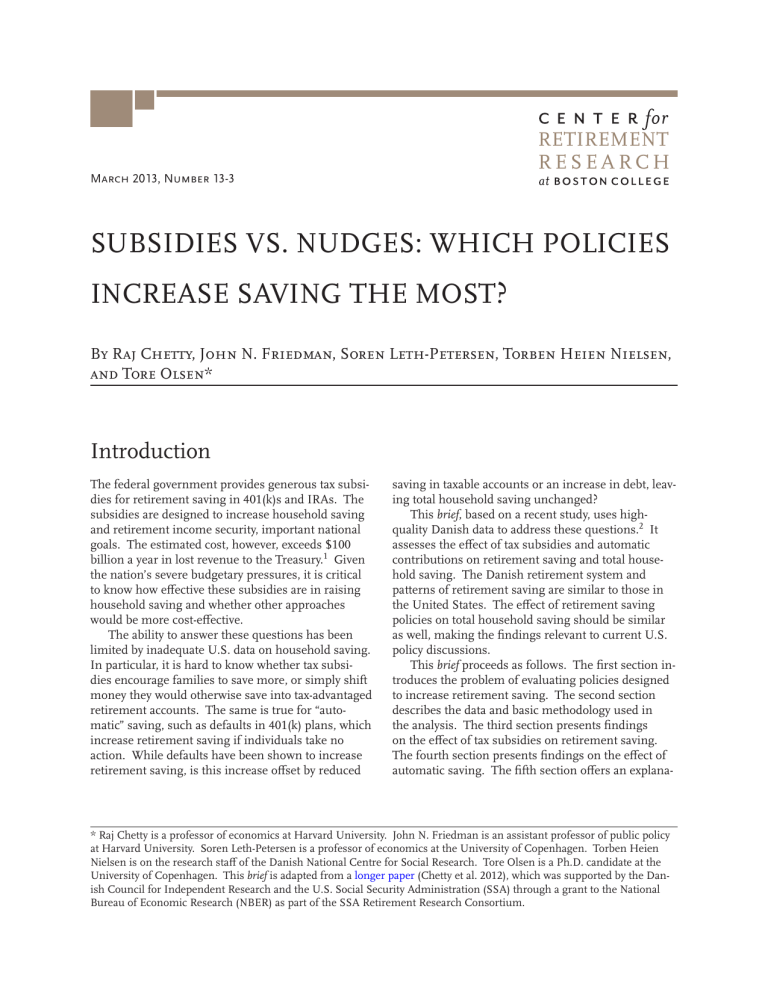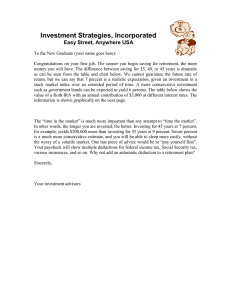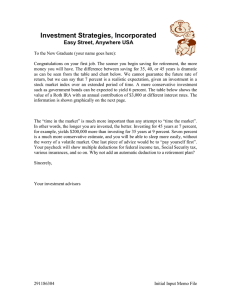
RETIREMENT
RESEARCH
March 2013, Number 13-3
SUBSIDIES VS. NUDGES: WHICH POLICIES
INCREASE SAVING THE MOST?
By Raj Chetty, John N. Friedman, Soren Leth-Petersen, Torben Heien Nielsen,
and Tore Olsen*
Introduction
The federal government provides generous tax subsidies for retirement saving in 401(k)s and IRAs. The
subsidies are designed to increase household saving
and retirement income security, important national
goals. The estimated cost, however, exceeds $100
billion a year in lost revenue to the Treasury.1 Given
the nation’s severe budgetary pressures, it is critical
to know how effective these subsidies are in raising
household saving and whether other approaches
would be more cost-effective.
The ability to answer these questions has been
limited by inadequate U.S. data on household saving.
In particular, it is hard to know whether tax subsidies encourage families to save more, or simply shift
money they would otherwise save into tax-advantaged
retirement accounts. The same is true for “automatic” saving, such as defaults in 401(k) plans, which
increase retirement saving if individuals take no
action. While defaults have been shown to increase
retirement saving, is this increase offset by reduced
saving in taxable accounts or an increase in debt, leaving total household saving unchanged?
This brief, based on a recent study, uses highquality Danish data to address these questions.2 It
assesses the effect of tax subsidies and automatic
contributions on retirement saving and total household saving. The Danish retirement system and
patterns of retirement saving are similar to those in
the United States. The effect of retirement saving
policies on total household saving should be similar
as well, making the findings relevant to current U.S.
policy discussions.
This brief proceeds as follows. The first section introduces the problem of evaluating policies designed
to increase retirement saving. The second section
describes the data and basic methodology used in
the analysis. The third section presents findings
on the effect of tax subsidies on retirement saving.
The fourth section presents findings on the effect of
automatic saving. The fifth section offers an explana-
* Raj Chetty is a professor of economics at Harvard University. John N. Friedman is an assistant professor of public policy
at Harvard University. Soren Leth-Petersen is a professor of economics at the University of Copenhagen. Torben Heien
Nielsen is on the research staff of the Danish National Centre for Social Research. Tore Olsen is a Ph.D. candidate at the
University of Copenhagen. This brief is adapted from a longer paper (Chetty et al. 2012), which was supported by the Danish Council for Independent Research and the U.S. Social Security Administration (SSA) through a grant to the National
Bureau of Economic Research (NBER) as part of the SSA Retirement Research Consortium.
2
Center for Retirement Research
The effect of tax subsidies is assessed using
responses to a sharp reduction in Denmark’s pension
tax subsidy, in 1999, for those in the top income tax
bracket. The question is whether those affected reduced their retirement saving and, if so, whether the
reduction was not offset by increases in other types
of saving. This outcome would indicate: 1) that the
subsidy had indeed induced households to increase
retirement saving; and 2) that the increase was not
the result of funds shifted from non-retirement to
subsidized retirement accounts, but represented an
increase in overall household saving.
Despite numerous studies on tax subsidies for retireThe effect of automatic retirement saving is asment saving, researchers have been unable to obtain
sessed in two ways: 1) the response of workers who
conclusive evidence on the effectiveness of these
switch jobs and receive an increase in automatic
subsidies in raising total household saving.3 Recent
retirement contributions made by their employers;
studies on automatic saving policies such as 401(k)
and 2) responses to the government’s Mandatory
defaults have found that they are quite effective at
Savings Plan, which from 1998-2003 required all
increasing participation in retirement saving proDanish citizens to contribute 1 percent of earnings to
grams but, again, it is unclear whether they raise total
a retirement savings account. The question is again
4
household saving.
whether households responded to an increase in
What impedes the ability to answer these quesautomatic retirement contributions by reducing other
tions is a lack of high-quality data on household
types of saving, leaving
wealth and saving in
total household saving
5
the United States.
unchanged. If so, it
Automatic
contributions
increased
total
Therefore, this study
would show that autoturns to data on Danish
saving much more than tax subsidies.
matic saving programs
households to address
simply shift, rather
these issues. The Danthan increase, total household saving.
ish retirement income system, which has individual
For a more complete description of the methodolsavings accounts, employer-provided pensions, and a
ogy used to create the data set and analyze the effects
government defined benefit plan, is broadly similar
of tax subsidies and automatic saving, see the full
to the structure in the United States. Saving behavior
working paper on which this brief is based.6
within retirement accounts – where good U.S. data
are available – is also similar. The assumption is that
saving behavior outside retirement accounts – where
the Danish data are of much higher quality – should
be similar as well.
tion of these findings based on how these policies
affect two types of individuals – “active” and “passive”
savers. The final section concludes that an expansion
of automatic saving could produce much larger increases in household saving, at lower fiscal cost, than
current tax subsidies for retirement saving.
Evaluating Retirement
Saving Policies
The Small Effect of
Tax Subsidies
Data and Methodology
Danish tax records allow the creation of a data set that
tracks the wealth and saving of over 4 million individuals from 1994-2009, producing 45 million total
observations. The data set combines information on
income, wealth, and saving from the Danish Income
Tax Register; on age, gender, and marital status from
the Danish population register; and on education, occupation, and employers from the Danish Integrated
Database for Labor Market Research. With this data
set, changes in tax subsidies and automatic retirement contributions can be used to analyze the effect
of such policies on household saving.
The effect of tax subsidies can be analyzed by examining how individuals responded to a reduction in
the subsidy for contributions to “capital” pension
accounts. Denmark has two types of tax-deferred
retirement savings accounts – “capital” pensions,
which provide lump-sum payouts at retirement, and
“annuity” pensions, which provide lifetime payments.
In 1999, the government reduced the subsidy for contributions to capital pension accounts for individuals
in the top tax bracket. The tax treatment of contributions to annuity pension accounts, and contributions
by individuals in lower tax brackets to either type of
account, remained unchanged.7
3
Issue in Brief
The effect of the subsidy can be assessed by comparing responses by individuals with incomes above
and below the income cutoff for the top tax bracket.
As one would expect, capital pension contributions
remained virtually unchanged for those not affected
by the subsidy reduction. Among those who were
affected, capital pension contributions fell sharply.
Contributions to annuity pensions by members of
this group did increase somewhat. Nevertheless, total
pension contributions by those in the top tax bracket,
to both capital and annuity accounts, declined significantly (see the bottom section of the bars in Figure 1).
This finding supports the notion that the higher tax
subsidy had indeed induced an increase in retirement
saving.
Figure 1. Saving for Individuals in Top Income Tax
Bracket, Before and After Tax Subsidy Reduction,
Thousands of DKr
Non-pension saving
25
Pension saving
21.7
21.6
15.1
16.3
6.6
5.3
Before subsidy reduction
(1996-1998)
After subsidy reduction
(1999-2001)
20
15
10
5
0
Notes: Pension saving includes saving in both capital accounts (which were affected by the subsidy reduction) and
annuity accounts (which were not affected). Non-pension
saving is expressed as a pre-tax amount. Over the period
studied, the exchange rate was about DKr 6.5 per US $1.
Source: Chetty et al. (2012).
However, the decline in retirement saving did not
produce a similar decline in total household saving.
Among those affected by the cut in the subsidy, saving in taxable non-pension accounts increased (see
the top section of the bars in Figure 1). The increase,
in fact, almost entirely offset the decline in their
retirement saving, as indicated by the nearly identical
height of the total bars in the figure. Each DKr 100
reduction in pension contributions led to only a DKr
2 reduction in overall saving. In other words, nearly
the entire increase in retirement saving attributable
to the previous level of the subsidy had come from
money that would have been saved – and was now being saved – in taxable non-pension accounts.
The government’s increased tax revenue due to
the lower subsidy can be estimated as the net present
value of the additional tax savings provided to taxpayers before the 1999 reform. Using this estimate in
the context of the example given above, it would cost
the government roughly DKr 200 to raise household
saving by DKr 2 (or DKr 1 in tax expenditure for each
1 cent increase in saving).
The subsidy not only had a small effect on total
household saving, it also affected very few households. Of those in the top tax bracket, 83 percent
essentially made no change in their pension and nonpension saving when the subsidy was cut.
The Large Effect of
Automatic Saving
The effect of automatic saving can be assessed by examining how individuals responded to an increase in
employer pension contributions when switching jobs
and to the introduction of the government’s mandatory saving program.
An increase in employer pension contributions
is an automatic increase in saving, as it requires no
active choices by the worker. In Denmark, employer
contributions vary substantially. So, many workers
who change jobs see a significant increase in such
automatic saving.
Workers who had been making voluntary contributions to an individual pension before changing jobs
can simply undo an automatic increase in pension
contributions made by a new employer. The two
forms of pension saving are perfect substitutes and
voluntary individual contributions are easily reduced.
Figure 2 (on the next page) shows employer pension
contributions and total household saving for such
workers who changed jobs and saw employer contributions increase by at least 3 percent of earnings.
The bottom section of the bars shows the big jump in
employer saving before and after the job change. The
top section of the bars shows only a relatively modest
reduction in individuals’ other saving (their own pension contributions plus non-pension saving) during
the same period. Thus, the lion’s share of the automatic increase in employer contributions was “passed
through” as an increase in total household saving.8
4
Center for Retirement Research
Figure 2. Saving Rate Before and After Job
Change to Firm with Higher Employer Pension
Contribution, Percentage of Salary
16
Other saving
Automatic saving
13.4
12
9.0
4.9
8
6.1
8.5
4
0
2.9
Before job change (t-1)
After job change (t)
Note: Automatic saving consists of employer pension
contributions. Other saving consists of individual pension
contributions and non-pension saving.
Source: Chetty et al. (2012).
The results are much the same for responses to
the government’s Mandatory Savings Plan (MSP).
This plan, in effect from 1998-2003, required all
Danish citizens to contribute 1 percent of earnings
to a retirement savings account. Retirement saving
increased in those years by about
1 percent of earnings, on average, with little reduction
in other types of saving. Saving increased even for
individuals who were previously saving more than
1 percent of earnings in voluntary individual pension
accounts, a nearly perfect substitute for the MSP.
Under both types of automatic contributions,
individual pension contributions and other types
of saving for the great majority changed very little.
As in the case of tax subsidies, only a small minority – about 15 percent – responded to the increase in
automatic pension contributions (either made by their
employer or required by the government mandate) by
reducing how much they saved on their own.
Active and Passive Savers
Why are automatic contributions so much more effective at raising saving than tax subsidies? The explanation seems to be that most individuals – about 85
percent of the population – are “passive” rather than
“active” savers.
Passive savers adjust how much they spend in
response to changes in disposable income. Money
in their pocket gets spent. Money not in their pocket
doesn’t. Automatic retirement contributions take
money out of an individual’s pocket. Passive savers
respond by reducing how much they spend, not by
adjusting how much they save in other accounts to
undo the effect of automatic saving.
Active savers, by contrast, make saving and spending decisions based on a life-cycle planning model.
They shift assets across savings accounts in response
to subsidies or automatic saving, instead of altering
their total saving.9 As a result, active savers tend to
thwart the purpose of any type of policy designed to
change their saving rate, either subsidies or automatic
saving.
Three pieces of evidence support the notion that
the distinction between active and passive savers, and
the predominance of the latter, is the primary reason
why automatic contributions and subsidies have very
different effects.
First, the 1999 subsidy reduction had much larger
effects on individuals who were starting a new pension that year, compared to those making pension
contributions in previous years. These individuals
were making active choices and should be more
responsive to incentives, consistent with evidence on
the importance of inertia in areas of life where individuals are not required to make active choices.10
Second, individuals who show themselves to be active savers, by changing pension contributions more
frequently in other years, were more responsive to the
reduction in the tax subsidy and more likely to offset
automatic contributions by changing individual pension contributions.
Third, individuals one could expect to be active
savers who plan for retirement and frequently adjust
their pension choices – those who have high wealthto-income ratios, who are older, or who have economics or finance training – were more responsive to
price subsidies and more likely to offset automatic
contributions.
5
Issue in Brief
Conclusion
Endnotes
Retirement saving policies can be distinguished based
on whether they change behavior through active or
passive choice. Tax subsidies rely on active choice.
To be effective, individuals must actively choose to
increase how much they save. Automatic saving
policies rely on passive acceptance. They are effective
unless individuals actively undo an automatic saving
increase.
The findings of this study call into question the
large tax expenditure currently used to induce individuals to save. The response in terms of increased
household saving is quite limited because most individuals are passive savers and the evidence suggests
that the small percentage of active savers tend to take
advantage of the subsidy without increasing the total
amount they save.
Automatic saving, which relies on passive choice,
is an attractive alternative. Automatic enrollment
or default policies could increase household saving
much more, at a much lower cost to the government,
because defaults are far more effective at increasing
the saving of passive savers.
1 Joint Committee on Taxation (2012).
2 Chetty et al. (2012).
3 See, for example, Engen, Gale and Scholz (1996)
and Poterba, Venti and Wise (1996).
4 Madrian and Shea (2001), Thaler and Sunstein
(2008).
5 Bernheim (2002).
6 Chetty et al. (2012).
7 Before 1999, contributions to both accounts had
been fully tax deductible, with income in the top tax
bracket (income above US $38,600 in 1998) taxed at
59 percent and income in the next tax bracket at 45
percent. Starting in 1999, the deduction for capital pension contributions for individuals in the top
income tax bracket was reduced from 59 cents to 45
cents per DKr. Other tax treatments remained the
same: capital pension payouts are taxed at 40 percent; annuity pension payments are taxed as regular
income; capital gains in both are taxed at 15 percent,
compared with an average of approximately 29 percent for assets in taxable accounts; withdrawals prior
to retirement from either account incur a tax of 60
percent plus administrative fees, making early withdrawals quite rare; and balances in capital pension
accounts can be converted to annuity pensions, but
the reverse is not allowed.
8 The saving impacts are equally large among individuals who switch employers because of a masslayoff at their prior employer, confirming that the
estimates are not biased by non-random sorting. The
changes in saving behavior persist for ten years after
the change in employers and result in higher wealth
at retirement.
9 This description of the saving behavior of passive
and active savers benefits from the description of
“spenders” and “savers” in Campbell and Mankiw
(1989) and Mankiw (2000).
10 Samuelson and Zeckhauser (1988), Ericson
(2012).
6
Center for Retirement Research
References
Bernheim, B. Douglas. 2002. “Taxation and Saving.”
In Handbook of Public Economics, edited by A. J.
Auerbach and M. Feldstein. Elsevier: Amsterdam.
Samuelson, William and Richard Zeckhauser. 1988.
“Status Quo Bias in Decision Making.” Journal of
Risk and Uncertainty 1(1): 7-59.
Campbell, John Y. and N. Gregory Mankiw. 1989.
“Consumption, Income and Interest Rates: Reinterpreting the Time Series Evidence.” In NBER
Macroeconomics Annual 1989, edited by Olivier J.
Blanchard and Stanley Fischer. Cambridge, MA:
National Bureau of Economic Research.
Thaler, Richard H. and Cass R. Sunstein. 2008. Nudge:
Improving Decisions About Health, Wealth, and
Happiness. New Haven: Yale University Press.
Chetty, Raj, John N. Friedman, Soren Leth-Petersen,
Torben Heien Nielsen, and Tore Olsen. 2012.
“Active vs. Passive Decisions and Crowd-Out in
Retirement Savings Accounts: Evidence from Denmark.” Working Paper 18565. Cambridge, MA:
National Bureau of Economic Research.
Engen, Eric M., William G. Gale, and John Karl
Scholz. 1996. “The Illusory Effects of Saving
Incentives on Saving.” Journal of Economic Perspectives 10(4): 113-38.
Ericson, Keith M. Marzilli. 2012. “Consumer Inertia
and Firm Pricing in the Medicare Part D Prescription Drug Insurance Exchange.” Working Paper
18359. Cambridge, MA: National Bureau of Economic Research.
Joint Committee on Taxation. 2012. “Estimates of
Federal Tax Expenditures for Fiscal Years 20112015.” JCS-1-12. Washington, DC.
Madrian, Brigitte C. and Dennis F. Shea. 2001. “The
Power of Suggestion: Inertia in 401(k) Participation and Savings Behavior.” The Quarterly Journal
of Economics 116(4): 1149-1187.
Mankiw, N. Gregory. 2000. “The Savers-Spenders
Theory of Fiscal Policy.” American Economic Review
90(2): 120-125.
Poterba, James M., Steven F. Venti, and David A.
Wise. 1996. “How Retirement Saving Programs
Increase Saving.” Journal of Economic Perspectives
10(4): 91-112.
RETIREMENT
RESEARCH
About the Center
The Center for Retirement Research at Boston College was established in 1998 through a grant from the
Social Security Administration. The Center’s mission
is to produce first-class research and educational tools
and forge a strong link between the academic community and decision-makers in the public and private
sectors around an issue of critical importance to the
nation’s future. To achieve this mission, the Center
sponsors a wide variety of research projects, transmits
new findings to a broad audience, trains new scholars, and broadens access to valuable data sources.
Since its inception, the Center has established a reputation as an authoritative source of information on all
major aspects of the retirement income debate.
© 2013, by Trustees of Boston College, Center for Retirement Research. All rights reserved. Short sections of text,
not to exceed two paragraphs, may be quoted without explicit permission provided that the authors are identified and
full credit, including copyright notice, is given to Trustees of
Boston College, Center for Retirement Research.
Affiliated Institutions
The Brookings Institution
Massachusetts Institute of Technology
Syracuse University
Urban Institute
Contact Information
Center for Retirement Research
Boston College
Hovey House
140 Commonwealth Avenue
Chestnut Hill, MA 02467-3808
Phone: (617) 552-1762
Fax: (617) 552-0191
E-mail: crr@bc.edu
Website: http://crr.bc.edu
The research reported herein was performed, in part, pursuant to a grant from the U.S. Social Security Administration
(SSA) funded as part of the Retirement Research Consortium. The opinions and conclusions expressed are solely
those of the authors and do not represent the opinions or
policy of SSA, any agency of the federal government, the
NBER, or the Center for Retirement Research at Boston
College.




